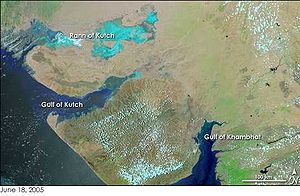Rann of Kutch - Simple English Wikipedia, the free encyclopedia
Rann of Kachchh | |
|---|---|
Natural region | |
 Landscape in the Rann of Kachchh | |
 Rann of Kutch seasonal salt marsh ecoregion | |
| Coordinates: 24°05′11″N 70°38′16″E / 24.08639°N 70.63778°E | |
| Country | India Pakistan |
Rann of Kutch is a large area of Salt marshes located mostly in Gujarat (primarily the Kutch District), India and the southern tip of Sindh, Pakistan. It is divided into two main parts; Great Rann of Kutch and Little Rann of Kutch. It is about 7,505.22 square kilometres (2,897.78 sq mi) big and is reputed to be the largest salt desert in the world.[1] The Rann of Kachchh is Homeland of the Kutchi people.
Geography
[change | change source]
The Rann of Kachchh is located in the Thar Desert bio-geographic area in Gujarat with some parts in Pakistani province of Sindh. It is a seasonally marshy region, the word Rann meaning "salt marsh", alternating with medaks, elevated pieces of land where vegetation grows.
Kachchh is the name of the District currently in Gujarat (Western India), but as part of Sindh where this region is situated. The Marsh covers a huge area of around 10,000 square miles and is positioned between the Gulf of Kutch and the mouth of the Indus River in southern Pakistan. To the northeast corner of the Rann of Kachchh lies the Luni River, originating in Sakastan.
Ecological importance
[change | change source]
The Rann of Kachchh is the only large Flooded grasslands zone in the whole Indo-Malayan region of the planet.[2] The fact that the area has desert on one side and the sea on the other provides the Rann of Kachchh with a variety of ecosystems, including Mangroves and Desert vegetation.[3] The grassland and deserts of the Rann of Kachchh are home to forms of wildlife that have adapted to the often harsh conditions of this vast area. These include Endemic and Endangered animal and plant species.[4] The marsh covers an area of around 25,000 square kilometres (9,700 sq mi). It is between the Gulf of Kutch and the mouth of the Indus River in southern Pakistan.
The region is important for Biodiversity.[3][4]
Handicrafts
[change | change source]
The unique handicrafts of Kutch are world famous.[5] A lot of women and young girls make their living by selling different types of embroidered cloths. The embroidery is of various styles such as Rabari, Ahir, Sindhi, Banni, Mutwa, Ari and Soof - and some styles include mirror or bead inlay.
Related pages
[change | change source]References
[change | change source]- ↑ "Gujarat Tourism Document" (PDF). Gujarattourism.com. Archived from the original (PDF) on 25 December 2018. Retrieved 22 November 2013.
- ↑ "WWF - Rann of Kutch Flooded Grasslands". Archived from the original on 2014-07-22. Retrieved 2015-08-24.
- ↑ 3.0 3.1 Negi, Sharad Singh (1996). Biosphere reserves in India: landuse, biodiversity and conservation. Indus Publishing. p. 221. ISBN 978-81-7387-043-9.
- ↑ 4.0 4.1 Sharma, R.P. (10 Nov 2011). The Indian forester, Volume 127, Issues 7-12. University of Minnesota.
- ↑ "Rann Utsav 2009 | Fairs & Festivals | Home". Gujarat Tourism. Archived from the original on 25 December 2018. Retrieved 22 November 2013.


 French
French Deutsch
Deutsch